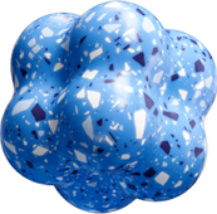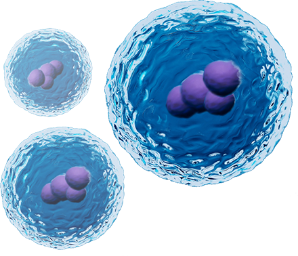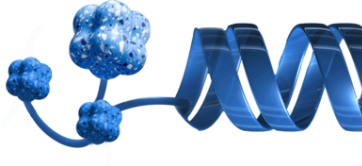INVESTIGATE THE SYNERGISTIC,
DISEASE-MODIFYING POTENTIAL
OF COMBINATION BET AND JAK INHIBITION THERAPY1,2
BET
In preclinical models, combination BET and JAK inhibition offered broader disease control by synergistically blocking NF‑κB hyperactivation1,2


Explore the potential of combined BET and JAK inhibition with Dr Andrew Kuykendall
And so, when we think about the future of myelofibrosis therapy, I think many people are talking about the potential for combination therapy.
Right now, we largely use single-agent approaches, mainly JAK inhibition.
But we know that that’s not enough, right?
We know that comprehensively we may need more than 1 agent to do that, and so when we think about the idea of combination therapy, it has to be leveraged in a way that makes sense.
So, the question is why would we do this?
And I think that we have to fall back on those unmet needs.
The unmet needs of cytopenias, durability of response, and the fact that it’s only a minority of patients that are achieving these spleen volume and symptom response rates.
And so, a combination therapy would need to bring to the table the ability to augment those responses, to really provide more substantial improvement in disease-related symptoms, more substantial improvement in organomegaly, more substantial improvement at the bone marrow level of changing the underlying biology of the disease.
The way I like to think about this is almost like a highway or an interstate or some sort of road system, and so if you’re thinking about the disease process as maybe the JAK-STAT pathway would form that interstate, right? The main thoroughfare to get from 1 place to another.
And JAK inhibitors have disrupted the therapeutic landscape by being able to block that pathway.
And if you block an interstate, you’re going to block a lot of the traffic from 1 area to another and a lot of the inflammation.
However, we know that by blocking that interstate we’re not getting disease responses.
We’re not getting eradication of the disease.
We’re not getting a ton of changes in bone marrow fibrosis or morphologic changes.
So, people are still getting around that interstate block, right, and so that’s where you have to think about state roads, alternative routes, and these are other inflammatory pathways that are overutilized and activated as well in myelofibrosis, but perhaps to a lesser extent.
And that’s where I think the shift has been more recently is focusing on these alternative strategies, these alternative pathways, that may need to be focused upon if we’re going to get meaningful disease responses. And so, one of these critical pathways is the NF-kappa-B pathway.
One of the ways in which we can target this NF-kappa-B pathway is by utilizing BET inhibitors.
So, BET inhibitors we know have many different target genes in and of themselves, but many of those are associated with this NF-kappa-B pathway.
And so, it may be by targeting both these pathways together with JAK inhibitors and BET inhibitors we can potentially achieve better responses.
And so, rationally, it makes sense to think about leveraging our ability to block 2 different inflammatory pathways and use those together.
And preclinically what we see when you combine BET and JAK inhibition is the ability to further improve spleen volume enlargement symptoms and erythroid differentiator or megakaryocyte differentiation leading to more erythrocyte production, more so than you’d see with either agent individually.
References:
- Al-Ali HK, Griesshammer M, le Coutre P, et al. Safety and efficacy of ruxolitinib in an open-label, multicenter, single-arm phase 3b expanded-access study in patients with myelofibrosis: a snapshot of 1144 patients in the JUMP trial. Haematologica. 2016;101(9):1065-1073. doi:10.3324/haematol.2016.143677
- Mesa R, Su Y, Woolfson A, et al. Development of a symptom assessment in patients with myelofibrosis: qualitative study findings. Health Qual Life Outcomes. 2019;17(1):61. doi:10.1186/s12955-019-1121-1
- Guglielmelli P, Rotunno G, Pacilli A, et al. Prognostic impact of bone marrow fibrosis in primary myelofibrosis. A study of the AGIMM group on 490 patients. Am J Hematol. 2016;91(9):918-922. doi:10.1002/ajh.24442
- Lacout C, Pisani DF, Tulliez M, et al. JAK2V617F expression in murine hematopoietic cells leads to MPD mimicking human PV with secondary myelofibrosis. Blood. 2006;108(5):1652-1660. doi:10.1182/blood-2006-02-002030
- Takenaka K, Shimoda K, Akashi K. Recent advances in the diagnosis and management of primary myelofibrosis. Korean J Intern Med. 2018;33:679-690. doi:/10.3904/kjim.2018.033
- NCCN Clinical Practice Guidelines in Oncology (NCCN Guidelines®) for Myeloproliferative Neoplasms V.3.2023. © National Comprehensive Cancer Network, Inc. 2023. All rights reserved. Accessed October 1, 2023. To view the most recent and complete version of the guideline, go online to NCCN.org
- Harrison CN, Schaap N, Mesa RA. Management of myelofibrosis after ruxolitinib failure. Ann Hematol. 2020;99(6):1177-1191. doi:10.1007/s00277-020-04002-9
- Scherber R, Mesa R. Management of challenging myelofibrosis after JAK inhibitor failure and/or progression. Blood Rev. 2020;42:100716. doi:10.1016/j.blre.2020.100716
- Pemmaraju N, Verstovsek S, Mesa R, et al. Defining disease modification in myelofibrosis in the era of targeted therapy. Cancer. 2022;128:2420-2432. doi:10.1002/cncr.34205
- Wilkins BS, Radia D, Woodley C, Farhi SE, Keohane C, Harrison CN. Resolution of bone marrow fibrosis in a patient receiving JAK1/JAK2 inhibitor treatment with ruxolitinib. Haematologica. 2013;98(12):1872-1876. doi:10.3324/haematol.2013.095109
- Vachhani P, Verstovsek S, Bose P. Disease modification in myelofibrosis: an elusive goal? J Clin Oncol. 2022;40(11):1147-1154. doi:10.1200/JCO.21.02246
- Kleppe M, Koche R, Zou L, et al. Dual targeting of oncogenic activation and inflammatory signaling increases therapeutic efficacy in myeloproliferative neoplasms. Cancer Cell. 2018;33(1):29-43. doi:10.1016/j.ccell.2017.11.009
- Verstovsek S, Mesa RA, Gotlib J, et al. A double-blind, placebo-controlled trial of ruxolitinib for myelofibrosis. N Engl J Med. 2012;366(9):799-807. doi:10.1056/NEJMoa1110557
- Jiang Q, Jamieson C. BET'ing on dual JAK/BET inhibition as a therapeutic strategy for myeloproliferative neoplasms. Cancer Cell. 2018;33(1):3-5. doi:10.1016/j.ccell.2017.12.007
- Ross D, Babon J, Tvorogov D, et al. Persistence of myelofibrosis treated with ruxolitinib: biology and clinical implications. Haematologica. 2011;106(5):1244-1253. doi:10.3324/haematol.2020.262691
- Copher R, Kee A, Gerds A. Treatment patterns, health care resource utilization, and cost in patients with myelofibrosis in the United States. Oncologist. 2022;27(3):228-235. doi:10.1093/oncolo/oyab058
- Naymagon L, Mascarenhas J. Myelofibrosis-related anemia: current and emerging therapeutic strategies. Hemasphere. 2017;1(1):e1. doi:10.1097/HS9.0000000000000001
- Bose P, Verstovsek S. JAK inhibition for the treatment of myelofibrosis: limitations and future perspectives. Hemasphere. 2020;4:4(e424). doi:10.1097/HS9.0000000000000424
- Mascarenhas J, Gerds A, Verstovsek S. Paradigm shift: combination BET and JAK inhibition in myelofibrosis. Leukemia. 2021;35(12):3361-3363. doi:10.1038/s41375-021-01405-z
- Hilton J, Cristea M, Postel-Vinay S, et al. BMS-986158, a small molecule inhibitor of the bromodomain and extraterminal domain proteins, in patients with selected advanced solid tumors: results from phase 1/2a trial. Cancers. 2022;14:4079. doi:10.3390/cancers14174079
In preclinical models, combined therapy against altered epigenetic regulation with BET inhibitors and activated signaling with JAK inhibitors resulted in1,2:
Restoration of the bone marrow microenvironment
Combined BET and JAK inhibition led to a complete reversal of bone marrow fibrosis in MF, increased erythrocyte production, and the normalization of megakaryocytes, suggesting the potential for normalized hematopoiesis.
Decreased extramedullary hematopoiesis (EMH) and spleen weights
Combined BET and JAK inhibition reduced spleen weights to a degree not observed by either therapy alone and resulted in the near-complete absence of splenic EMH.
A marked reduction in serum levels of inflammatory cytokines
These data suggest that combination BET and JAK inhibition should be further explored to evaluate its ability to impact clinical outcomes in MF1
MorphoSys is committed to looking deeper into the synergistic, disease-modifying potential of combination BET and JAK inhibition to address all 4 hallmarks of MF





